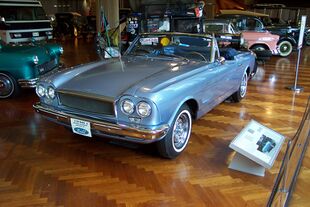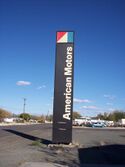Engineering:Budd XR-400
| Budd XR-400 | |
|---|---|
 | |
| Overview | |
| Manufacturer | Budd Company |
| Body and chassis | |
| Class | Concept car |
| Body style | Sports car |
| Layout | FR layout |
| Powertrain | |
| Engine | 327 cu in (5.4 L) V8 |
| Transmission | 3-speed automatic |
| Dimensions | |
| Wheelbase | 108 inches (2,743 mm) |
The XR-400 was a fully operational concept car.[1] A "sporty" youth-oriented convertible was built in 1962 by the Budd Company, an independent body builder in Detroit, Michigan, for evaluation by the fourth largest U.S. automaker at the time, American Motors Corporation (AMC).[2]
Origin
The XR-400 was developed and constructed by the Automotive Division of the Budd Company.[3] The "X" stood for experimental and the "R" stood for Rambler.[4] The trunk lid featured Rambler lettering as the intended customer of the car.[2]
The objective of this car was to entice AMC to expand into a new market segment with a low-cost Rambler-based "sports convertible."[5] The Budd Company was a long-time supplier of tooling, parts, and bodies to Automotive industry . Budd also worked with Nash Motors, AMC's predecessor company, to develop the 1941 Nash 600, the first unibody (unitized) automobile body in the United States in 1940, the predecessor of the modern mass-produced car.[6][7]
Examples of Budd's experiments include the first all-plastic bodied automobile developed for Studebaker in 1954.[8] This prototype logged thousands of test miles on public roads.[9] Its contracts included the manufacture of Thunderbird bodies for Ford starting in 1955 through 1957.[9][10] In 1962, Budd proposed to replicate the original two-seat Thunderbird design on a Ford Falcon platform, but Ford rejected the idea.[11][12][13] Budd's XT-Bird idea was then redeveloped using an AMC platform and shown to AMC.[11]
By appealing to AMC with its concept vehicle, Budd's already existing business with AMC would increase. It wanted to supply bodies and major sub-assemblies to the automaker for a production version of this new car.[14] Budd estimated that the new model could be available for public sale by October 1963,[15] six months ahead of the Ford Mustang.[16]
Design
The XR-400 was built on a two-door 1962 Ambassador chassis.[17] To keep costs down, Budd engineers kept front of the unit body with the suspension in the same location. The engine's position was lowered by two inches (51 mm) with new rear mounts, the radiator was lowered by 3.5 inches (89 mm), the fan blades were shortened, as was the oil-filler neck.[4] The air cleaner was relocated, the exhaust system was reshaped, and the gas tank was new.[4]
The XR-400's long nose was achieved by extending the front section and adding a cowl behind it that held the battery.[18] The car was styled by Budd with a rather clean and uncluttered body giving little indication of its Rambler sedan origin. A double crease in the beltline suggested a family relationship to the contemporary styling of Rambler's large-sized cars.
The proposed model was a true 2+2 (two front bucket seats plus limited use seats for two back passengers) sleek, steel-blue convertible with a long hood and a short, stubby rear deck.[2] The XR-400's long 108-inch (2,743 mm) Ambassador wheelbase and truncated overhangs gave it athletic proportions, while the top-up appearance suggested a close-coupled two-seater sports car. Classic sports car touches included a hood line that slopped lower than the front fenders, doors that had a dip in their top, and simulated air extractors behind the front wheels.[2]
Power for the XR-400 was supplied by a standard Ambassador two-barrel 250 hp (186 kW; 253 PS) 327 cu in (5.4 L) AMC V8 engine.[19] The engine bay could accommodate any of AMC's I6 or V8 engines. The transmission was an automatic (not typical of sports cars) controlled through a floor console mounted shift lever.[15] Braking was provided by an experimental front disc brake system.[20]
The interior used AMC's front seats and many other hardware items. In classic sports car fashion, the driver had all controls and a full set of instruments (speedometer, tachometer, as well as gauges for fuel, water temperature, amperes, and oil pressure) that mounted directly ahead of a three-spoke wood-rimmed Nardi (brand) steering wheel.[21]
Budd's sales pitch to AMC included pioneering a market "presently untapped by any other manufacturer" with a car that "unlike anything else on the road it would attract widespread attention, provide your dealers with both a new profit area and morale-builder, and offer unusual advertising and sales promotion opportunities."[22]
Expectations
The experimental convertible was publicly exhibited at the 1964 meeting of the Society of Automotive Engineers (SAE).[3] The press release stated that the concept shows how modifying Rambler Ambassadors results in:
- "... A brand new type of car—one designed specifically to take over a healthy segment of the new car market presently untapped by any American manufacturer...."[15]
Automotive press reports stated that such a new model could have appeared in AMC dealer showrooms, thus establishing a market segment at least six months before Ford's similar Mustang started the "pony car" market.[6] Unfortunately, AMC turned down the idea.[23] There were several reasons for this decision, including:[24][25]
- American Motors' President George W. Romney, who cemented the company as a maker of compact cars, left the company in February 1962 to run for governor of Michigan.
- The new model had very little interior room to compete successfully against other sporty compact cars such as the Chevrolet Corvair Monza and the Pontiac Tempest Le Mans.
- American Motors was developing entirely new models for 1963 and this was a major capital drain. Entering a completely new market segment with an unproven car could be a costly gamble.
- The company was itself working on a new compact fastback concept car called the Rambler Tarpon using the soon-to-be-introduced third-generation Rambler American platform.
Legacy
The Budd Company kept the only prototype model, but later renamed it "XR-Budd" and used it for marketing purposes. The Rambler lettering on the rear of the trunk lid was removed, while the stamped steel wheels with full wheel covers were upgraded to chrome-plated reverse wheels with exposed lug nuts. Budd sold the prototype to The Henry Ford Museum in 1997.[26] It is now at the museum and also displayed at major classic car shows.[27]
References
- ↑ "Prototypes and Show Cars: XR-400". http://www.amxfiles.com/amc/proto.html.
- ↑ Jump up to: 2.0 2.1 2.2 2.3 Janicki, Ed (April 1965). "Budd's Mustang – a prototype "family sports car" by an independent body builder". Car Life 12: 60–61. http://wildaboutcarsonline.com/members/AardvarkPublisherAttachments/9990392211839/1965-04_CL_Budd_XR-400_Mustang_Clone_1-2.pdf. Retrieved 26 March 2022.
- ↑ Jump up to: 3.0 3.1 "Budd-Built Beauty". Automotive Industries (Chilton) 130 (12): 47. 15 June 1964. https://books.google.com/books?id=KkZWAAAAMAAJ&q=The+XR400+was+developed+and+constructed+by+the+Automotive+Div.+of+the+Budd+Co. Retrieved 26 March 2022.
- ↑ Jump up to: 4.0 4.1 4.2 Vaughan, Daniel (August 2010). "1962 AMC Rambler Budd XR-400". https://www.conceptcarz.com/z18654/AMC-Rambler-Budd-XR-400.aspx.
- ↑ "1962 Budd XR-400 Sports Convertible". 6 November 2007. http://auto.howstuffworks.com/1962-budd-XR400-sports-convertible.htm.
- ↑ Jump up to: 6.0 6.1 Strohl, Daniel (9 January 2008). "Rambler's Mustang? the Budd XR-400". Hemmings. https://www.hemmings.com/stories/2008/01/09/ramblers-mustang-the-budd-xr-400.
- ↑ "Chrysler moves to Unibody (unit-body construction): 1960". https://www.allpar.com/fix/body/unit-body.html.
- ↑ Carpenter, Lauren (18 June 2013), "The Budd Manufacturing Company", transcendinginbw, "In 1954, the company introduced the first all-plastic bodied automobile for Studebaker. (Retrieved 26 March 2022. from transcendinginbwdotcom.wordpress.com/2013/06/17/the-budd-manufacturing-company/ )"
- ↑ Jump up to: 9.0 9.1 "Suppliers on a Roll". Automotive Industries (Chilton Company) 176: 77. 1996. https://books.google.com/books?id=mZcqAQAAMAAJ&q=Budd+XR-400. Retrieved 26 March 2022.
- ↑ Long, Brian (2016). The Book of the Ford Thunderbird from 1954. Veloce Publishing. ISBN 978-1-84584-700-5. https://books.google.com/books?id=rOt1CwAAQBAJ&dq=1955+Thunderbird+bodies+made+by+Budd&pg=PT93. Retrieved 26 March 2022.
- ↑ Jump up to: 11.0 11.1 Andreina, Don (20 October 2020). "Automotive History: The Short Life And Personal Times Of The 1955-1957 Thunderbird". https://www.curbsideclassic.com/automotive-histories/automotive-history-the-short-life-and-personal-times-of-the-1955-1957-thunderbird/.
- ↑ "Test Driving a One-of-a-Kind '60s Concept Car". The Henry Ford. 14 June 2019. https://www.youtube.com/watch?v=6TbGl_dgq4I.
- ↑ "1962 Budd XT-Bird Concept Car – The Henry Ford". The Henry Ford. https://www.thehenryford.org/collections-and-research/digital-collections/artifact/212457/.
- ↑ Wright, Richard A. (10 January 2000). "Rare special cars highlight Ford collection". The Detroit News. http://apps.detnews.com/apps/joyrides/index.php?id=72. "...two purposes in mind: to demonstrate Budd's capabilities and as a proposal for manufacture of a small, sporty personal car."
- ↑ Jump up to: 15.0 15.1 15.2 "Ready for Motor Muster: Budd XR-400 Concept Car". The Henry Ford. 14 June 2019. https://www.thehenryford.org/explore/blog/ready-for-motor-muster-budd-xr-400-concept-car/.
- ↑ Wright, Richard A. (21 April 2003). "Ford museum preserves greatest moments in automotive history". The Detroit News. http://info.detnews.com/redesign/joyrides/index.cfm?id=392. "...the Budd XR-400 could have gone into production six months ahead of Ford's Mustang..."
- ↑ "XT-Bird Becomes XR-400". 6 November 2007. http://auto.howstuffworks.com/1962-budd-XR400-sports-convertible2.htm.
- ↑ The Henry Ford (19 June 2009). "The Henry Ford conservation specialists preparing the Budd XR-400 for Motor Muster". https://www.youtube.com/watch?v=ZSvxLXL7bpE.
- ↑ Strohl, Daniel (22 February 2013). "Never-was Rambler-based pony car headed to Keels and Wheels". Hemmings. https://www.hemmings.com/stories/2013/02/22/never-was-rambler-based-budd-xr-400-headed-to-keels-and-wheels.
- ↑ "The Henry Ford preps pony cars for Motor Muster". The Henry Ford Museum. 19 June 2009. http://blog.thehenryford.org/2009/06/the-henry-ford-preps-pony-cars-for-motor-muster/.
- ↑ Shea, Terry (October 2016). "Nardi". Hemmings Sports & Exotic Car. https://www.hemmings.com/stories/article/nardi. Retrieved 26 March 2022.
- ↑ "Budd Company's Pitch to AMC". 6 November 2007. http://auto.howstuffworks.com/1962-budd-XR400-sports-convertible3.htm.
- ↑ Theobald, Mark (2004). "Edward G. Budd Mfg. Co. – 1912-1946 – Budd Co. 1946-present". http://www.coachbuilt.com/bui/b/budd/budd.htm.
- ↑ "Why AMC Passed on the 1962 Budd XR-400". 6 November 2007. http://auto.howstuffworks.com/1962-budd-XR400-sports-convertible4.htm.
- ↑ "The XR-400 wouldn't have saved AMC, but it pointed in a useful direction". 7 July 2021. https://www.indieauto.org/2021/07/07/the-xr-400-wouldnt-have-saved-amc-but-it-pointed-in-a-useful-direction/.
- ↑ Strohl, Daniel (22 February 2011). "Never-was Rambler-based pony car headed to Keels and Wheels". http://retrohotrod.com/never-was-rambler-based-pony-car-headed-to-keels-and-wheels/.
- ↑ "18th Annual Keels & Wheels Concours d'Elegance to Showcase Concept Car". Michigan Meetings & Events. 8 March 2013. https://mi.meetingsmags.com/article/18th-annual-keels-wheels-concours-delegance-showcase-concept-car.
- Foster, Patrick (December 2014). "The Budd XR-400, American Motors' Almost Thunderbird". Hemmings Classic Car 11 (123).
- Janicki, Ed (June 1993). "1962 BUDD XR-400 Sports Convertible, AMC's Knocked Opportunity". Collectible Automobile 12: 60. http://xa.yimg.com/kq/groups/15630644/2137777011/name/XR400+-+AMCs+missed+opportunity.pdf. Retrieved 26 March 2022.
- Kozak, Graham (23 February 2014). "Budd XR-400: The AMC Mustang that wasn't". Autoweek. https://www.autoweek.com/car-life/a1888541/budd-xr-400-amc-mustang-wasnt/.
- McGuire, Bill (22 June 2019). "Video: Test-Driving the 1962 Budd XR-400 Concept". https://www.macsmotorcitygarage.com/video-test-driving-the-1962-budd-xr400-concept/.
- "Getting a '60s Era Concept Car in Running Condition". The Henry Ford. 12 June 2019. https://www.youtube.com/watch?v=TVk70t8w8ns.
 |


